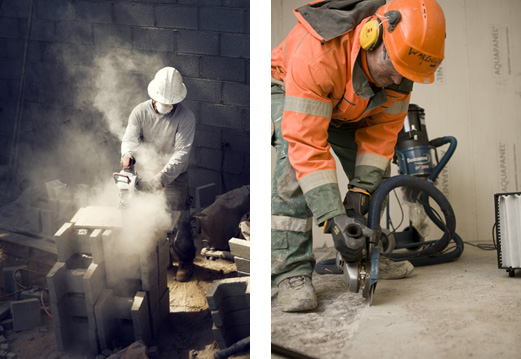Dust in the air is ubiquitous. And the danger the dust might contain is invisible. The dusty air can contain several substances which threaten our health.
Dust which is visible is usually bigger than 10 µm (1 µm = 0,001 mm). Single hazardous particles are hence invisible. In high concentrations they though can become visible.
Dust can be defined as a collection of particles which consist of one or more substances and with particle sizes between 0.1 µm and 100 µm. The weight of the particles is only so high that they float in the air flow and thus occur in the air we breathe.
The smaller the particles, the better they follow the air flow. A large dust particle descends, whilst a smaller dust particle floats in the air. The descending, bigger dust particle is rather harmless. The smaller, floating dust particles on the other hand can in high concentration be hazardous and threaten our health.

Pictures: The picture to the left shows cutting in concrete without a suction casing and the right picture shows the same procedure with one of Dustcontrols' suction casings. As you can see there is no airborne hazardous dust with source extraction from Dustcontrol.
We distinguish between two types of dust in the air:
- Aerosols
Dust particles floating in the air are called aerosols. All air contains these aerosols in large numbers. Normal outdoor air contains usually over 40 million particles per cubic meter air measuring over 0.3 µm.
Causes for the formation of aerosols
There are several causes for dust, as well as for smoke. Dust is created mostly in the industry via abrasion of materials and in the nature via erosion.
Examples of hazardous aerosols
- rock dust
- desert dust
- grit
- abrasion of car tires
- polishing dust
- concrete dust etc. - Smoke
What we call smoke is actually a mixture of solid particles of dust, gases and water molecules. The particles are very small (smaller than 0.003 mm), but due to their high concentration they are visible.
Causes for the formation of smoke
Smoke is supplied into the air by various causes. It is a result of incomplete combustion of organic substances or caused by heavy evaporation.
Examples of hazardous smokes
- cigarette smoke
- vehicle exhaust
- factory exhaust
- welding fumes
- oil smoke
- heating
Conclusion
The prevention of dust is most effective if we recognize dust as a hazard, identify its source and fight it at its source. If that is not possible, appropriate countermeasures must be applied, eg. personal protective equipment and/or dust extraction systems.
An article in an article series of dust in six parts
- Dust: The Invisible Danger
- Dust: The Causes
- Dust: Hazard of Asbestos
- Dust: Hazard of Silicosis
- Dust: Hazards in Welding
- Dust: Hazard of Asthma in Bakeries
By Thomas Pfister, expert commentator in occupational safety at experto.de
 United Kingdom
United Kingdom  Sverige
Sverige  Deutschland
Deutschland  Suomi
Suomi  Austria
Austria  United States
United States  .com
.com  France
France 
 01327 858002
01327 858002
